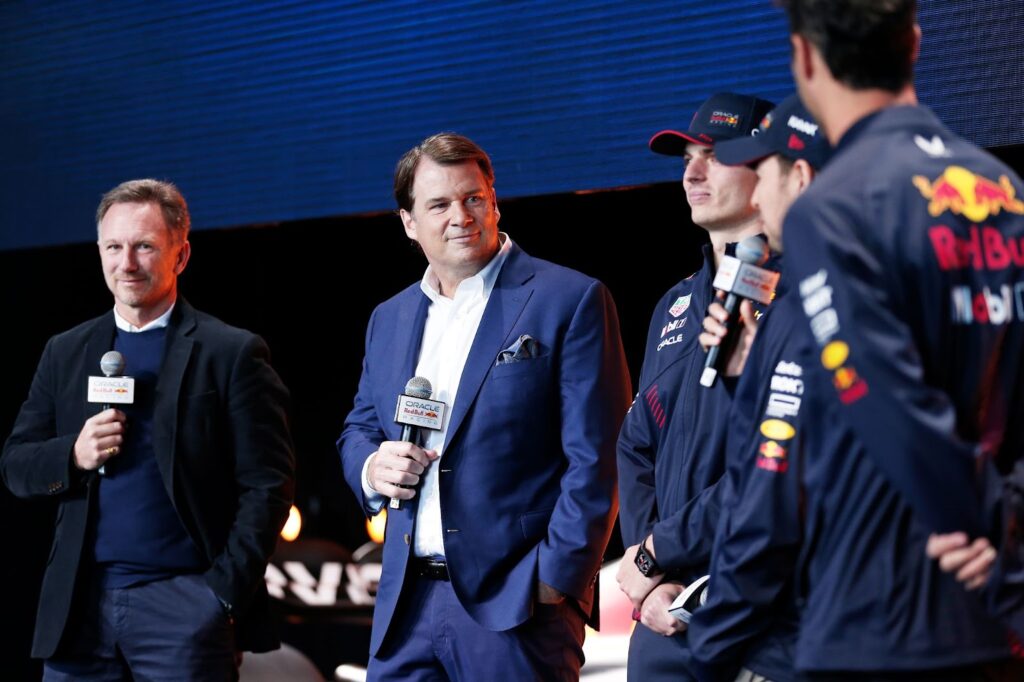Ford is back on the Formula 1 (F1) circuit. For the first time since 2004, the American automaker will be working in racing’s elite competition. They couldn’t have inked a deal with a better racing team: Red Bull Racing. After a decade of being second-best to Mercedes, the team is climbing back to the top, and Ford is helping it.
The 2021 and 2022 champions are setting themselves up for their period of dominance. The 2023 Formula 1 season kicks off on March 5 with the Bahrain Grand Prix.
The deal was announced on Feb. 3 at Red Bull’s F1 season launch party in New York City. The two firms will work together on new power units ahead of the 2026 season. That’s when the racing league is enacting new technical regulations. Sustainable fuels and greater electric power in cars will be required as the F1 continues to scale up its carbon neutrality measures.
Red Bull needs an engine provider with experience in electric powertrains. On the flip side, Ford is looking to re-enter a league they didn’t anticipate to become so popular in the U.S. — a win-win situation.
The 2026 rule changes require teams to switch to at least a 350-kilowatt electric motor. That’s three times more electric power than the current hybrid engines. When coupled with 100% sustainable race fuel, the reigning champions were not going to contract any manufacturer. They needed a carmaker with proven success in developing reliable, powerful engines. Ford has done that with its growing line of civilian electric vehicles (EVs), such as the Mustang Mach-E.
“Ford will assist with battery and hybrid technology and much more to keep the Team ahead of the competition,” said Christian Horner, Red Bull’s F1 team principal, in a statement. “I am already very excited about the possibilities that this partnership will offer both of us globally.” The deal goes beyond developing electrical F1 car technology.

Photo Courtesy Red Bull Racing
Red Bull has captured a massive share of the American fanbase. According to Horner, out of 50 million U.S. F1 fans, 72% root for Red Bull. This launch party in New York City was the first time such an event was held outside the U.K.
Along with the driver development team, Scuderia AlphaTauri, the brand has a lot of influence. Ford picked the perfect time to return to the circuit — F1’s popularity is at an all-time high.
Many new fans followed the team after watching the Netflix docuseries “Drive to Survive,” boosting F1’s waning U.S. interest.
Ford isn’t slacking with its electrification strategy. It will invest an impressive $50 billion into EV development. Red Bull and AlphaTauri will be able to tap into a massive network of scientists, engineers, and executives dedicated to making the very best electric powertrains. Horner said more information sharing was likely to happen between the two companies. As greater research and development occurs, improvements to car performance will become easier to implement.

Photo Courtesy Red Bull Racing
Despite not participating for over two decades, Ford is the third most successful engine producer in the league’s history. Their last championship-winning car was driven by the legendary Michael Schumacher. Now, they’ll work alongside Max Verstappen, the champion driver of the past two seasons. Hopefully, the American manufacturer will help him win more titles and spur more EV adoption.
“Ford’s return to Formula 1 with Red Bull Racing is all about where we are going as a company — increasingly electric, software-defined, modern vehicles and experiences,” said Jim Farley, president and CEO of Ford. “F1 will be an incredibly cost-effective platform to innovate, share ideas and technologies, and engage with tens of millions of new customers.”





